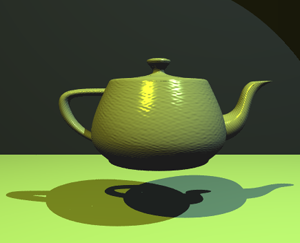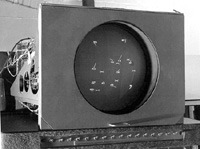Teaching:TUW - UE InfoVis WS 2007/08 - Gruppe 09 - Aufgabe 1 - Computer Graphics: Difference between revisions
No edit summary |
No edit summary |
||
| Line 8: | Line 8: | ||
==Subfields== | ==Subfields== | ||
<br> | |||
Computer Graphics may be divided into four major categories: | Computer Graphics may be divided into four major categories: | ||
===Geometry=== | |||
Studies ways to represent and process surfaces | |||
===Animation=== | |||
Studies with ways to represent and manipulate motion | |||
===Rendering=== | |||
Studies algorithms to reproduce light transport | |||
===Imaging=== | |||
Studies image acquisition or image editing | |||
==History== | |||
<br> | |||
[[Image:whirlwind.jpg |thumb|200px|Whirlwind displays aircraft positions and auxiliary information.]] | [[Image:whirlwind.jpg |thumb|200px|Whirlwind displays aircraft positions and auxiliary information.]] | ||
In the <b>60's</b>, Jack Bresenham published how to draw lines on a raster device. He later extended this to circles. Larry Roberts pointed out the usefulness of homogeneous coordinates, 4x4 matrices and hidden line detection algorithms. Steve Coons introduced parametric surfaces and developed early computer aided geometric design concepts. The earlier work of Pierre Bézier on parametric curves and surfaces also became public. | |||
In the <b>70's</b>, rendering (shading) was discovered by Gouraud and Phong at the University of Utah. Turned Whitted developed recursive ray tracing which became the standard for photorealism. One of the first displays of computer animation was Futureworld (1976), which included an animation of a human face and hand — produced by Ed Catmull and Fred Parke also at the University of Utah. | |||
In the <b>80's</b>, Jim Blinn introduced blobby models and texture mapping concepts. Binary space partitioning (BSP) trees were introduced as a data structure. Loren Carpenter started exploring fractals in computer graphics. Postscript was developed by John Warnock.Steve Cook introduced stochastic sampling to ray tracing. Video arcade games took off. | |||
In the <b>90's</b>, Mosaic, the first graphical Internet browser was written. OpenGL became the standard for graphics APIs.Dynamical systems (physically based modeling) that allowed animation with collisions, gravity, friction, and cause and effects were introduced. Surface subdivision algorithms were rediscovered. Wavelets begin to be used in computer graphics. Image based rendering became the area for research in photo-realistic graphics. | |||
==Application== | ==Application== | ||
[[Image:Pov_ray.png|thumb|300px|Glasses (created by using POV-Ray 3.6).]] | |||
<br> | |||
* graphs and charts | * graphs and charts | ||
* computer-aided design | * computer-aided design | ||
Revision as of 12:34, 9 November 2007

Definition
Subfields
Computer Graphics may be divided into four major categories:
Geometry
Studies ways to represent and process surfaces
Animation
Studies with ways to represent and manipulate motion
Rendering
Studies algorithms to reproduce light transport
Imaging
Studies image acquisition or image editing
History

In the 60's, Jack Bresenham published how to draw lines on a raster device. He later extended this to circles. Larry Roberts pointed out the usefulness of homogeneous coordinates, 4x4 matrices and hidden line detection algorithms. Steve Coons introduced parametric surfaces and developed early computer aided geometric design concepts. The earlier work of Pierre Bézier on parametric curves and surfaces also became public.
In the 70's, rendering (shading) was discovered by Gouraud and Phong at the University of Utah. Turned Whitted developed recursive ray tracing which became the standard for photorealism. One of the first displays of computer animation was Futureworld (1976), which included an animation of a human face and hand — produced by Ed Catmull and Fred Parke also at the University of Utah.
In the 80's, Jim Blinn introduced blobby models and texture mapping concepts. Binary space partitioning (BSP) trees were introduced as a data structure. Loren Carpenter started exploring fractals in computer graphics. Postscript was developed by John Warnock.Steve Cook introduced stochastic sampling to ray tracing. Video arcade games took off.
In the 90's, Mosaic, the first graphical Internet browser was written. OpenGL became the standard for graphics APIs.Dynamical systems (physically based modeling) that allowed animation with collisions, gravity, friction, and cause and effects were introduced. Surface subdivision algorithms were rediscovered. Wavelets begin to be used in computer graphics. Image based rendering became the area for research in photo-realistic graphics.
Application

- graphs and charts
- computer-aided design
- virtual-reality environment
- data visualisation
- education and training
- computer art
- entertainment
- image processing
- graphical user interfaces
External links
Futureworld at the Internet Movie Database
References
[Fetter, 1966] W. A. Fetter, Computer Graphics in Communication, McGraw-Hill Book Company, New York, 1965.
[Wikipedia, 2007] Wikipedia, Computer Graphics. Retrieved at: November 8, 2007. http://en.wikipedia.org/wiki/Computer_graphics.